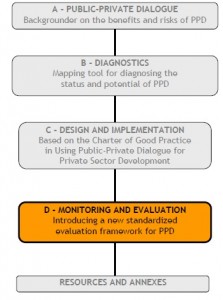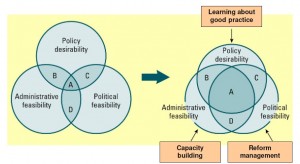This component of the evaluation exercise assesses the extent to which a PPD has been beneficial in starting up and implementing reforms identified as priorities by national governments.
D.5.1. Three elements of political economy reform
The political economy reform process depends on three related elements:
PPD can contribute to all three elements. Its main impact is likely to be on raising the importance of issues on the government’s agenda and building a constituency for reform, and thus increasing the policy desirability and feasibility of these reforms.
Through government participation in PPD, officials are exposed to exchange of experiences that
contribute to capacity-building within the public sector. However, additional efforts are needed to build capacity for public sector reform processes.
The relation between these three elements is shown in the following figure23:
Practitioners should be aware that governments can be impelled towards reform by other processes and actors. International development partners can influence reforms through dialogue and financial incentives. Political decentralization processes can also have an effect.
So it is difficult to attribute political economy reforms fully to PPD. Nonetheless, it is in this area that PPD is most likely to have its most significant impact.
D.5.2. Clarifying the steps of the reform process: drafting, executive, legislative
Reform processes differ from country to country. For each context, the evaluator should attempt to categorize the typical set of steps of the reform process.
For instance, for a state level legislative amendment in Bosnia and Herzegovina the steps are the following:
A) Drafting
1. Identification of issue and potential for reform (first written document about the issue).
2. Pre-drafting public-private consultations.
3. Agreement from a minister to champion the bill.
4. Amendment during the technical drafting process.
5. Public-private consultation during the drafting process.
6. Production of final amendment draft.
7. Decision of minister to forward the bill to the Council of Ministers.
B) Executive
8. Decision to put the amendments on the agenda of the Council of Ministers.
9. Adoption by the Council of Ministers.
C) Legislative
10. Decision to put on the agenda of Parliament.
11. Two readings by the House of Representatives.
12. Adoption by the House of Representatives.
13. Two readings by the House of Peoples.
14. Adoption by the House of Peoples,
15. Harmonization by the relevant Parliamentary committees of each house in the event the
versions adopted differ,
16. Publication in the Official Gazette.
Although the number and kind of specific steps in a reform process can vary significantly between countries, the categories of a) drafting steps, b) executive steps and c) legislative steps can be distinguished in any given country.
Once this is done, a table is created with all the steps indicated by a different column. Each row represents a single bill, an amendment to a law, regulation or decree, or anything else that the PPD claims to have had an impact on. It is advisable to choose only the most significant reforms – say, a maximum of 10 – to which the PPD contributed.
Following the different data collection methods, the evaluator needs to rate each step, in terms of the level of influence, which the PPD had on the step being measured. This level of influence can be indexed on a scale from 0 to 3. This would mean that for each given reform and given step the following scores
are possible:
0 – The PPD had no impact on this step.
1 – This step benefited from input from the PPD.
2 – The role of the PPD was crucial in the accelerating this step.
3 – The PPD was solely responsible for this step.
Final scorings can only be conducted after detailed analysis and cross-checking of the data collected, because it is likely that opinions on the degree of influence of a PPD on a specific reform and step will greatly vary among different stakeholder groups.
The rating of the level of influence can be summarized and visualized in a table with color coding to illustrate the evaluated impact of the PPD on the reform process of all the regulatory or legislative changes it will claim to have contributed to.
This illustration is based on the 16-step reform-process in Bosnia-Herzegovina:
This table can be converted to colors to give quick visual information to readers as to where the PPD has been most influential.
In this example, it is clear that the impact of the PPD on the reform process lies at the beginning of the process, in identifying issues and organizing the consultation process during the drafting phases. The PPD also plays a significant role during the different readings at the two houses of parliament.
Ranking steps in order of the importance of the PPD’s influence leads to an understanding of where a PPD is currently most effective, and where it may need to focus more attention.
Evaluation of the Political Economy Impact of PPDS on Reform Processes




